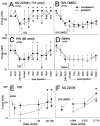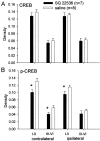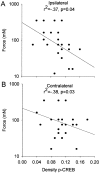Phosphorylation of CREB and mechanical hyperalgesia is reversed by blockade of the cAMP pathway in a time-dependent manner after repeated intramuscular acid injections
- PMID: 12843242
- PMCID: PMC6741249
- DOI: 10.1523/JNEUROSCI.23-13-05437.2003
Phosphorylation of CREB and mechanical hyperalgesia is reversed by blockade of the cAMP pathway in a time-dependent manner after repeated intramuscular acid injections
Abstract
Spinal activation of the cAMP pathway produces mechanical hyperalgesia, sensitizes nociceptive spinal neurons, and phosphorylates the transcription factor cAMP-responsive element binding protein (CREB), which initiates gene transcription. This study examined the role of the cAMP pathway in a model of chronic muscle pain by assessing associated behavioral changes and phosphorylation of CREB. Bilateral mechanical hyperalgesia of the paw was induced by administering two injections of acidic saline, 5 d apart, into the gastrocnemius muscle of male Sprague Dawley rats. Interestingly, the increases in immunoreactivity for CREB and phosphorylated CREB (p-CREB) in the spinal dorsal horn occur 24 hr, but not 1 week, after the second injection of acidic saline compared with pH 7.2 intramuscular injections. Spinal blockade of adenylate cyclase prevents the expected increase in p-CREB that occurs after intramuscular acid injection. The reversal of mechanical hyperalgesia by adenylate cyclase or protein kinase A inhibitors spinally follows a similar pattern with reversal at 24 hr, but not 1 week, compared with the vehicle controls. The p-CREB immunoreactivity in the superficial dorsal horn correlates with the mechanical withdrawal threshold such that increases in p-CREB are associated with decreases in threshold. Therefore, activation of the cAMP pathway in the spinal cord phosphorylates CREB and produces mechanical hyperalgesia associated with intramuscular acid injections. The mechanical hyperalgesia and phosphorylation of CREB depend on early activation of the cAMP pathway during the first 24 hr but are independent of the cAMP pathway by 1 week after intramuscular injection of acid.
Figures






Similar articles
-
Inhibition of the cyclic adenosine monophosphate pathway attenuates neuropathic pain and reduces phosphorylation of cyclic adenosine monophosphate response element-binding in the spinal cord after partial sciatic nerve ligation in rats.Anesth Analg. 2007 Dec;105(6):1830-7, table of contents. doi: 10.1213/01.ane.0000287652.42309.5c. Anesth Analg. 2007. PMID: 18042889
-
Effects of NMDA and non-NMDA ionotropic glutamate receptor antagonists on the development and maintenance of hyperalgesia induced by repeated intramuscular injection of acidic saline.Pain. 2002 Jul;98(1-2):69-78. doi: 10.1016/s0304-3959(01)00471-7. Pain. 2002. PMID: 12098618
-
Activation of protein kinase C in the spinal cord produces mechanical hyperalgesia by activating glutamate receptors, but does not mediate chronic muscle-induced hyperalgesia.Mol Pain. 2006 Apr 3;2:13. doi: 10.1186/1744-8069-2-13. Mol Pain. 2006. PMID: 16584564 Free PMC article.
-
Reflections on: "A general role for adaptations in G-Proteins and the cyclic AMP system in mediating the chronic actions of morphine and cocaine on neuronal function".Brain Res. 2016 Aug 15;1645:71-4. doi: 10.1016/j.brainres.2015.12.039. Epub 2015 Dec 29. Brain Res. 2016. PMID: 26740398 Free PMC article. Review.
-
Neuroprotective Methodologies in the Treatment of Multiple Sclerosis Current Status of Clinical and Pre-clinical Findings.Curr Drug Discov Technol. 2021;18(1):31-46. doi: 10.2174/1570163817666200207100903. Curr Drug Discov Technol. 2021. PMID: 32031075 Review.
Cited by
-
Machine learning identifies fatigue as a key symptom of fibromyalgia reflected in tyrosine, purine, pyrimidine, and glutaminergic metabolism.Clin Transl Sci. 2024 Mar;17(3):e13740. doi: 10.1111/cts.13740. Clin Transl Sci. 2024. PMID: 38411371 Free PMC article.
-
Neurotrophin-3 reverses chronic mechanical hyperalgesia induced by intramuscular acid injection.J Neurosci. 2004 Oct 20;24(42):9405-13. doi: 10.1523/JNEUROSCI.0899-04.2004. J Neurosci. 2004. PMID: 15496676 Free PMC article.
-
Enhancement of presynaptic glutamate release and persistent inflammatory pain by increasing neuronal cAMP in the anterior cingulate cortex.Mol Pain. 2008 Sep 29;4:40. doi: 10.1186/1744-8069-4-40. Mol Pain. 2008. PMID: 18823548 Free PMC article.
-
Endogenous PI3K/Akt and NMDAR act independently in the regulation of CREB activity in lumbosacral spinal cord in cystitis.Exp Neurol. 2013 Dec;250:366-75. doi: 10.1016/j.expneurol.2013.10.015. Epub 2013 Oct 30. Exp Neurol. 2013. PMID: 24184018 Free PMC article.
-
Fibromyalgia: Pathogenesis, Mechanisms, Diagnosis and Treatment Options Update.Int J Mol Sci. 2021 Apr 9;22(8):3891. doi: 10.3390/ijms22083891. Int J Mol Sci. 2021. PMID: 33918736 Free PMC article. Review.
References
-
- Anderson LE, Seybold VS ( 2000) Phosphorylated cAMP response element binding protein increases in neurokinin-1 receptor immunoreactive neurons in rat spinal cord in response to formalin-induced nociception. Neurosci Lett 283: 29–32. - PubMed
-
- Bear MF, Connors BW, Paradiso MA ( 2001) Neuroscience: exploring the brain. In: Molecular mechanisms of learning and memory (Katz S, ed), pp 804–805. Baltimore: Lippincott Williams & Wilkins.
-
- Bennett RM ( 1995) Fibromyalgia: the commonest cause of widespread pain. Compr Ther 21: 269–275. - PubMed
-
- Blitzer RD, Wong T, Nouranifar R, Iyengar R, Landau EM ( 1995) Postsynaptic cAMP pathway gates early LTP in hippocampal CA1 region. Neuron 15: 1403–1414. - PubMed
Publication types
MeSH terms
Substances
Grants and funding
LinkOut - more resources
Full Text Sources
